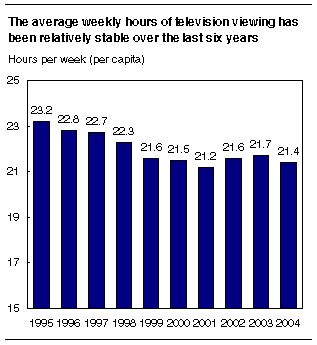
















 |
|
 |                |
Information identified as archived is provided for reference, research or recordkeeping purposes. It is not subject to the Government of Canada Web Standards and has not been altered or updated since it was archived. Please "contact us" to request a format other than those available.

|

Friday, March 31, 2006 Television viewing
Canadians spent less time watching sports and programs with Canadian content in the fall of 2004, perhaps as a result of the cancellation of the National Hockey League season. Canadians spent 6.5% of their television viewing time tuned into sports in the fall of 2004, down from 8.2% in 2003. People were also spending less time watching programs with Canadian content, with viewer time falling to 37.2% in 2004 from 40.2% a year earlier. Among all the age/gender groups, men aged 18 and older account for the majority of viewers of sports programs. In the fall of 2004, they spent 11.3% of their time watching sports broadcasts, down from 14.3% in 2003. Both anglophone and francophone television viewers watched less sports. The proportions of total viewing time spent on sports programs was down to 3.2% in 2004 from 5.5% in 2003 among francophones, and down to 7.7% from 9.3% among anglophones. Significant decrease in Canadian contentThe cancellation of the 2004/05 National Hockey League season also significantly reduced Canadian content viewing. In the fall of 2004, it represented 45% of sports programming, a significant drop from 62% in 2003. In previous years, Canadian sports programming viewing had been relatively stable. This, in turn, affected the overall proportion of television viewing of programs with Canadian content. On conventional Canadian television stations, Canadian content dropped to 54.1% in 2004 from 56.5% in 2003. On Canadian pay and specialty channels, Canadian programs accounted for only 36.8% of viewing, down from 44% in 2003.
Variety and game shows contributed to viewer stabilityNevertheless, Canadians continued to watch almost the same number of hours of television per week in the fall of 2004 as they did in 2003. Hockey fans may have turned to variety and game shows (including reality TV), which gained in popularity. These programs took 15.2% of total viewing time in 2004 compared to 12.9% in 2003, with all of the increase going to foreign shows. This was true for both anglophone and francophone viewers as well as for viewers of all age/gender groups. Drama and comedy continued to take up the lion's share of Canadian viewers' time (37.3%). Close to 82% of this viewing time was spent on foreign programs. News and public affairs shows were the second most popular at 24.4%. Unlike the drama and comedy category, Canadian news and public affairs shows attracted the most viewers (75%). 
Teens continue to watch less televisionIn the fall of 2004, teens aged 12 to 17 spent 12.9 hours a week in front of the TV, two hours less than in 2003 and almost three hours less than five years ago. This drop can partly be attributed to the Internet. According to the survey data on household spending, Internet use in households with children under 18 has risen substantially, from 50% in 1999 to 82% in 2004. News and public affairs programs experienced the sharpest decline with teen viewers. In 2004, teens spent only 9.4% of their total viewing time on this type of show, down from 17.4% in 2003. The full brunt of this loss came from Canadian programs. The most noticeable decreases in television viewing among teen viewers was seen in Ontario and New Brunswick (almost four hours less than the previous year), followed by Prince Edward Island (three hours less) and Newfoundland and Labrador (close to two hours less). Men aged 18 to 24 watched the least amount of television (12.3 hours a week), whereas women 60 and over watched the most (35.6 hours a week). Provincially, New Brunswick viewers spent the most amount of time in front of the TV, an average of 23.7 hours a week, followed closely by Quebec at 23.3 hours a week. In sharp contrast, Alberta viewers continued to watch the least amount of television in Canada (19.4 hours a week). Available on CANSIM: tables 502-0001 to 502-0005. Definitions, data sources and methods: survey number 3114. Selected details from the fall 2004 Television Viewing Survey are now available for free online in table format in Television Viewing: Data Tables (87F0006XIE, free). Data from the survey are also available by province. Researchers can request special tabulations on a cost-recovery basis. For more information, or to enquire about the concepts, methods or data quality of this release, contact Client Services, Culture Statistics Program (1-800-307-3382 or 613-951-7608; fax: 613-951-9040; cult.tourstats@statcan.gc.ca), Culture, Tourism and the Centre for Education Statistics.
| |||||||||||||||||||||||||||||||||||||||||||||||||||||||||||||||||||||||||||||||||||||||||||||||||||||||||||||||||||||||||||||||||||||||||||||||||||||||||||||||||||||||||||||||||||||||||||||||||||||||||||||||||||||||||||||||||||||||||||||||||||||||||||||||||||||||||||||||||||||||||||||||||||||||||||||||||||||||||||||||||||||||||||||||||||||||||||||||||||||||||||||||||||||||||||||||||||||||||||||||||||||||||||||||||||||||||||||||||||||||||||||||||||||||||||||||||||||||||||||||||||||||||||||||||||||||||||||||||||||||||||||||||||||||||||||||||||||||||||||||||||||||||||||||||||||||
|
|
|